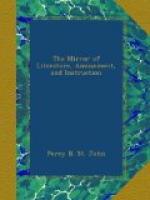Title: The Mirror of Literature, Amusement, and Instruction Vol. 13, No. 374
Author: Various
Release Date: March 17, 2004 [EBook #11611]
Language: English
Character set encoding: ASCII
*** Start of this project gutenberg EBOOK the mirror of literature ***
Produced by Jonathan Ingram, Allen Siddle, and the
Online Distributed
Proofreading Team.
THE MIRROR OF LITERATURE, AMUSEMENT, AND INSTRUCTION.
Vol. 13, No. 374.] Saturday, June 6, 1829. [Price 2_d_.
* * * * *
HOLLAND HOUSE, KENSINGTON
[Illustration: Holland House, Kensington.]
Since the time of William III., who was the first royal tenant of the palace, Kensington has been a place of considerable interest, as the residence and resort of many celebrated men. The palace, however, possesses little historical attraction; but, among the mansions of the parish, Holland House merits especial notice.
Holland House takes its name from Henry Rich, Earl of Holland, and was built by his father-in-law, Sir Walter Cope, in the year 1607, of the architecture of which period it affords an excellent specimen. Its general form is that of an half H. The Earl of Holland greatly improved the house. The stone piers at the entrance of the court (over which are the arms of Rich, quartering Bouldry and impaling Cope) were designed by Inigo Jones. The internal decorations were by Francis Cleyne. One chamber, called the Gilt Room, which still remains in its original state, exhibits a very favourable specimen of the artist’s abilities; the wainscot is in compartments, ornamented with cross crosslets and fleurs de-lis charges, in the arms of Rich and Cope, whose coats are introduced, entire, at the corner of the room, with a punning motto, alluding to the name of Rich, Ditior est qui se. Over the chimneys are some emblematical paintings, done (as the Earl of Orford observes) in a style and not unworthy of Parmegiane. The Earl of Holland was twice made a prisoner in his own house, first by King Charles, in 1633, upon occasion of his challenging Lord Weston; and a second time, by command of the parliament, after the unsuccessful issue of his attempt to restore the king, in August, 1648. The Earl, who was a conspicuous character during the whole of Charles’s reign, and frequently in employments of considerable trust, appears to have been very wavering in his politics, and of an irritable disposition. In 1638, we find him retired to his house at Kensington, in disgust, because he was not made Lord Admiral. At the eve of the civil war, he was employed against the Scots; when the army was disbanded, having received some new cause of offence,




